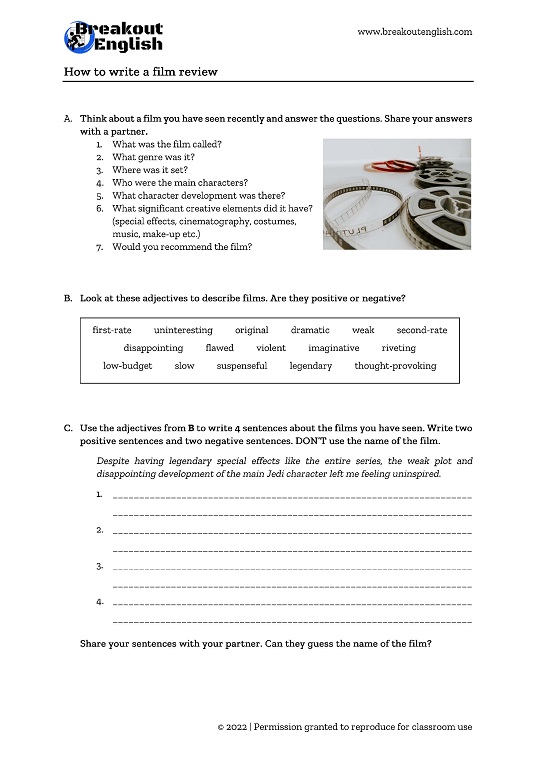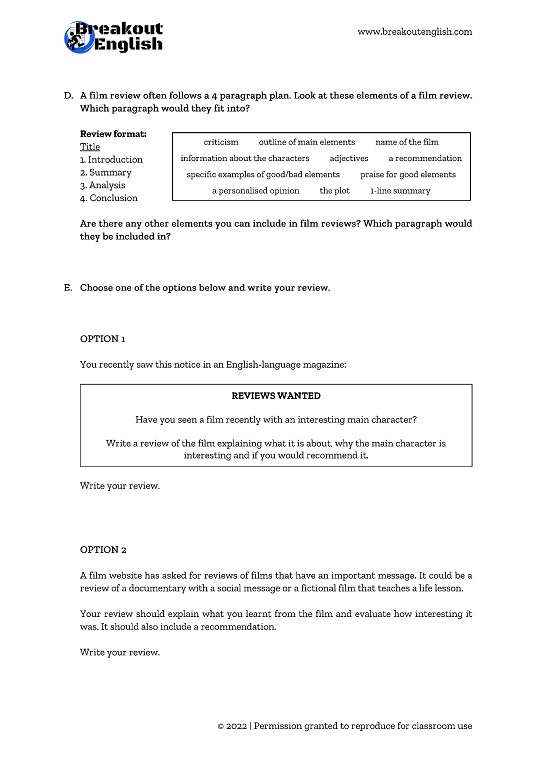Writing a review is an option in many different English language exams, and films are such an obvious choice for reviews, so knowing how to write a film review is pretty important. It’s a great topic for the classroom too. Everyone watches films and there is a lot of opportunity to teach vocabulary, either film-related vocabulary or film review adjectives. I like to start off a class about films with some chat, or my personal favourite, the Movie Music Quiz, which also now has an excellent Movie Picture Quiz version too.

Contents
The structure of a film review
Like any writing task, it’s essential to know the structure of a film review before you start writing. A basic film review template shows you how to write a film review using a simple structure. Film reviews for First (FCE) and Advanced (CAE) Cambridge exams, as well as Trinity ISE exams, should all use a 4 paragraph structure. Another thing to remember is that your review should always have a title, and that title should include the name of the film.
- Introduction – Essential details and mini-summary
- Summary – A description of the film and some important details
- Analysis – An evaluation of different elements
- Conclusion – Your opinion and a recommendation
Introduction
In the introduction of a film review, it is crucial to mention the film title and the names of the director and the main actors. A brief summary of the film’s plot and background information can also be included, but it should not give away too much detail. The introduction should engage the reader and entice them to continue reading the review. Additionally, it is important to mention the genre and target audience of the film, which will give the reader an idea of what to expect.
Summary
In the summary section, the film review should give a comprehensive but concise description of the film, focusing on the plot, characters, and any significant events. The summary should be written in a way that does not give away the ending or spoil the film for the reader. It is important to maintain objectivity and not include personal opinions in this section. This section should provide enough detail for the reader to have a clear understanding of the film without giving too much away.
Analysis
The analysis section is where the reviewer can showcase their critical skills and provide an in-depth evaluation of the film. The review should examine various elements of the film such as the script, direction, cinematography, acting, and special effects. You could also make a comparison to similar films in the same genre. The analysis should be written in an objective style with the opinion only showing through the language used.
Conclusion
In the conclusion, the reviewer should give their personal opinion of the film, summarising their thoughts on its strengths and weaknesses. They should also consider the target audience and whether they believe the film will appeal to them. Finally, the reviewer should provide a clear recommendation. The conclusion should be concise, leaving the reader with a clear understanding of the reviewer’s overall opinion of the film.
Using adjectives in reviews
Reviews are a great way to show off your language with impressive adjectives. If you read a film review in a newspaper or magazine, you’ll notice that the reviewer rarely, if ever, gives an explicit direct opinion. However, their opinion of the film is always crystal clear. This is through the use of adjectives.
Many adjectives have a clear connotation. They are either perceived as positive or negative. Compare these two examples. Which one is a positive description and which is negative?
- It’s a first-rate experience with an imaginative plot and a star-studded cast.
- The second-rate writing combined with weak performances is typical of this director’s work.
When using adjectives in a film review, it is important to choose words that accurately convey the reviewer’s opinion. Adjectives with strong connotations, either positive or negative, can be very effective in expressing the reviewer’s thoughts about the film. However, it is also important to use a variety of adjectives to avoid repetition and keep the review interesting. The use of adjectives can also help to paint a picture of the film, allowing the reader to get a sense of its atmosphere and tone.

The materials
Many exams, such as the Cambridge First (FCE) and Advanced (CAE) exams, as well as Trinity ISE exams, require students to write a film review as part of their writing task. These materials will provide students with a solid understanding of the structure of a film review and help them to develop their writing skills. This will give them the confidence they need to write a review that meets the requirements of the exam and impresses the examiner.
The materials will help you learn how to write an introduction, summary, analysis, and conclusion of a film review. You will also see a range of useful adjectives that you can use to express your opinions in their reviews. Finally, you will get an opportunity to practise writing film reviews, which will help you to develop your skills. Then you can check your answers with the samples provided in the answer key. Whether you’re preparing for an exam or just looking to improve your writing skills, these materials will provide you with everything you need to write a great film review.
Download




Interesting and useful material to be used in class.
thanks!